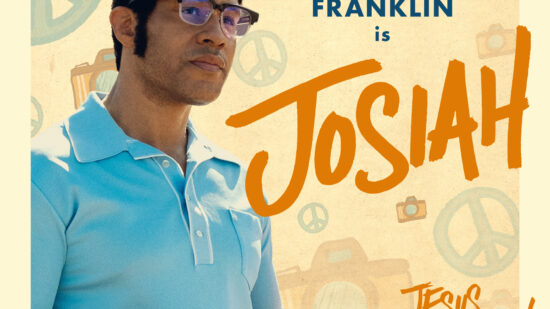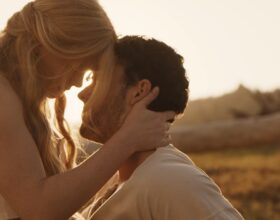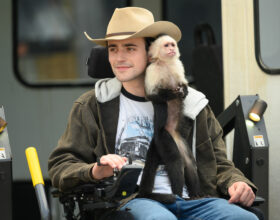by Edwin L. Carpenter – Associate Editor, The Dove Foundation
 Bob Dolman, the writer and director of “How to Eat Fried Worms,” recently spoke with The Dove Foundation on the topic of his experiences on the film, and something he learned about himself while making the movie. We opened the interview with Bob explaining how he took the book and adapted it into a movie.
Bob Dolman, the writer and director of “How to Eat Fried Worms,” recently spoke with The Dove Foundation on the topic of his experiences on the film, and something he learned about himself while making the movie. We opened the interview with Bob explaining how he took the book and adapted it into a movie.
“The biggest challenge was that the book is small,” he said, “and there wasn’t, in my opinion, enough to turn it into a movie. I had to add things. It’s a beautiful book in that it is fun to read from chapter to chapter, but in a movie that becomes episodic and a little tedious, and the twists and turns weren’t enough. I thought that rather than stick to what’s in the book in terms of its plot and its characters, I would expand that but I would try my best to stay true to the spirit of the book which I really liked when I first read it. So, staying with the spirit of it, I think it really captured the innocence of children and children’s concerns beautifully. That was my main task when I was writing it.”
“And then I added characters like Erica. There were no girls in the book. We added the little boy Woody, the younger brother, as there were no siblings for Billy in the book. And then I added more kids and the plot of him coming to a new school. There was quite a bit that we added. It was really just a matter of inventing without losing the anchor, as I say, the real spirit of the book.”
“We had great fun. It’s very hard to direct children in that their attention span is not great and they really don’t want to stay put with a lot of adults telling them what to do. I found that to be the only challenge. Otherwise, they were beautifully natural and playful and their spirits were always high. I really loved directing them. You hear the old adage that the hardest thing to direct is a child or a dog! I didn’t find that about kids at all. I thought they were really easy going.”
“We did have one day there where Billy (Luke Benward) was just cracking up,” Dolman said with a chuckle. “It’s something that actors will do. It comes from being nervous but it’s so infectious and if you get everybody doing it it’s a hard thing to undo. I remember saying to them, ‘Now guys, you know we only have so much time and we can’t keep shooting film and having you laugh—how are we going to get serious?’ And of course when you say something like that it only gets worse. They just finally got worn out and we got it back!”
When we asked Mr. Dolman what all went into the making of the worms, he said, “Eventually there is going to be a great little report on that on our DVD but that won’t come out till Christmas. We had the special effects people do a little movie for us on how they made the worms. It will explain it better than I can.” He did say that gelatin was included in the mix and other food items to make the worms appear real and yet edible.
“There’s one particularly gross worm that Billy eats. It’s called the ‘greasy brown toad bloater special!”” (This drew a chuckle from this writer). “It’s supposed to be deep fried with liver juice on it. In fact it’s made of portabella mushrooms and molasses. I don’t know if that sounds any better! It’s edible!” he laughed.
Dolman said they had lots of the “real” thing on hand. “We had a worm farm set up in our basement of the production office. We tried to be as respectful to those worms as possible.” In fact, the film displays a disclaimer that no worms were hurt during the making of the movie. “Some people thought it didn’t seem to matter, but I felt like if it didn’t matter at all—if you didn’t draw a line it was significant and people would maybe abuse it, and we didn’t want to hurt any animals and we stuck to that. The boys put the worms down their pants and those were all real worms—not saying the worms didn’t have a weird experience!” Dolman chuckled again.
 We asked Dolman about challenges in making the film, besides the attention span of the kids. “One big challenge was that we shot in Austin, Texas, and it was summer and it was probably a hundred degrees every day. For the crew and for the actors it was a challenge to keep the pace going. You don’t notice it on film but we really noticed it when we were shooting. We did come back and do some re-shooting in the spring and it was cooler and I noticed a big difference there— that everybody was efficient and we moved faster.”
We asked Dolman about challenges in making the film, besides the attention span of the kids. “One big challenge was that we shot in Austin, Texas, and it was summer and it was probably a hundred degrees every day. For the crew and for the actors it was a challenge to keep the pace going. You don’t notice it on film but we really noticed it when we were shooting. We did come back and do some re-shooting in the spring and it was cooler and I noticed a big difference there— that everybody was efficient and we moved faster.”
As the process of filmmaking goes, the movie wasn’t yet finished after shooting. “We did get in the editing room and we tested the movie back in January and we learned a lot about it and went back and shot a few scenes to improve the movie. One example is the scene when Adam Simms (Austin Rogers), the boy who dances at the end, is dancing in the convenient store on the dance machine. If you really look at that closely you’ll notice the boys do look older, especially the boy playing Adam Simms. He aged and matured over the year—probably went through puberty because he was now taller and had a deeper voice. He’d become thinner too and so we had to put a fat suit on him to try and match him up and his face was quite different but audiences don’t notice.”
Dolman said he had started on this particular project approximately ten years ago. He was hired as a writer but not with the company which ultimately produced it. “I decided to direct something I had written called ‘The Banger Sisters,’” he said. “It was produced by Mark Johnson. And when we finished we had enjoyed working together on the small budget movie. Mark said, ‘Let’s do another small movie.’ I said, ‘Well, there’s this script about fried worms which has been sitting on the shelf for some time. I think it’s a shame because kids would really enjoy this story.’ And so we dug it out and went around with it, and it took a couple of years to sell it but we finally did. And by then I had directed a movie so I had some experience and a taste of it and enjoyed the experience. So I tried it again.” Dolman’s credits include writing the screenplay for the Ron Howard film, “Willow,” and he wrote several episodes of “WKRP in Cincinnati.” He took on directing at age fifty.
Ron Howard was the one who encouraged him to direct for the first time and he said it was a difficult thing to do initially but that he relied on his writing to help guide him through the process. Dolman is open to future directorial duties and his peers have expressed an interest in him directing more children’s movies, “because I worked so well with the kids,” he said. “I did too—I got along with them so well. I’m not sure that’s the direction I’ll go in, but it’s really nice to be asked.” This is the thing he learned about himself—that he had a rapport with the kids that he did not expect going into the project. Whether or not he directs again soon, Dolman still thinks of himself “as primarily a writer.”
We asked Dolman if he was particularly happy with certain scenes in the film and he said, “Most of the time you look at a movie at the end and you’re a little disappointed because the picture of it in your mind is not always the same as what ends up on the screen. But I felt like what we had on the screen—and it sounds like kind of a boast I guess—but I felt like what we had on the screen was better than I ever imagined it. I was very pleased. One thing I couldn’t have anticipated was how great the kids come across. When you’re writing something you see the characters but you don’t see the casting. We just nailed it with the casting I think. We got kids who are very natural and real and I just enjoy watching them so much and they have to take a lot of the credit for the way this movie turned out.”
He added that the kids worked well with the two adult actors, James Rebhorn and Clint Howard. The kids asked Rebhorn questions about his technique, and Dolman said every time they took a break he would look over and see Clint Howard surrounded by about six kids and they were all laughing. Howard, a child actor himself, shared some of his experiences with the kids.
In conclusion, we asked Dolman about future plans and he is writing “an adult comedy about two brothers in middle age at the time their father dies. It’s about a reconciliation that takes place during the funeral. I’ve been working on that for some time. It’s a bit personal. There are a lot of emotional issues in it that resonate for me.” This is a script he would like to direct.
“I really enjoyed working with these kids so much. I am definitely open about listening to projects that have to do with children. Not everybody can do what I did and that is become a kid myself and have a great rapport with the kids. I didn’t even know I had that! I raised two children myself and I guess some of it rubbed off. I was able to communicate with them and draw out of them what we needed for the movie. It was such a pleasant surprise for me. I thought, ‘Maybe this is a knack that I never really realized I had.’ So if another script came along that was a good script, or a script that I write, I certainly would do another kid’s movie, yes.”
The tentative date for the DVD release of “How to Eat Fried Worms,” is December 12. “There’s going to be a lot of good bonus material in that,” added Dolman. “There will be some deleted scenes and funny little blooper reels, and the making of the worms and so on.
Bob Dolman wanted to conclude with the comment that keeping the spirit of the book was so important, and that “the concerns of children were in the foreground. I mean the concerns of children that are appropriate to childhood—we live in this world where kids have to go to school where there are guns or kids have to deal with sexuality way too early and all that, and it’s just way more than a ten or eleven-year-old mind is meant to hold. So we thought, ‘Let’s make a movie in which the concerns are appropriate to kids.’ He added that the elements in the film—going to a new school and trying to fit in and being picked on are hard, “but they’re not outside the realm of what ought to be difficult for a child and that is important thematically. I felt it in the book and felt like we got it across in the movie. I hope that is something that is appreciated because it’s probably the most important thing about the movie as far as I’m concerned.”
Dolman obviously has a knack in relating to the kids that he worked with in the film and we suspect that, whatever future projects he works on, somewhere down the line he will find himself once again directing kids.




